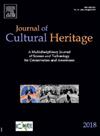基于oct的油画裂纹形态定量分析
IF 3.3
2区 综合性期刊
0 ARCHAEOLOGY
引用次数: 0
摘要
对艺术品裂缝进行彻底的三维定量分析,可以获得有关艺术品保存、修复和真实性的宝贵而深入的信息。在本研究中,对每种类型的裂缝都获得了高分辨率的三维光学相干断层扫描(OCT)图像,并提取了裂缝的截面图像。在裂缝的整个长度上测量宽度和深度分布,在裂缝的整个高度上测量z轴切片截面积。分析表明,直线裂缝在宽度和深度上的变化最为显著。相反,垂直裂缝在宽度和深度方面表现出最小的变化。此外,径向裂缝在深度上表现出比宽度更大的变异性。z轴截面积从裂缝中心到两端或从裂缝中心水平轴基准的一侧增加。利用这些精确的艺术品测量数据,可以优化保存和修复工作,从而为鉴别赝品提供科学依据。这种方法可以防止对艺术品的美学、经济和历史价值的损害,并有助于其适当的保存。本文章由计算机程序翻译,如有差异,请以英文原文为准。
OCT-based quantitative analysis of craquelure morphology in an oil painting
A thorough three-dimensional quantitative analysis of an artwork crack can yield valuable and in-depth information regarding the preservation, restoration, and authenticity of the artwork. In this study, high-resolution three-dimensional optical coherence tomography(OCT) images were obtained for each type of crack, and cross-sectional images of the cracks were extracted. The width and depth distributions were measured over the entire length of the cracks, and the z-axis slice cross-sectional areas were measured over the entire height of the cracks. The analysis revealed that straight cracks exhibited the most significant variations in width and depth. In contrast, vertical cracks exhibited minimal variability in terms of width and depth. Furthermore, radial cracks exhibited greater variability in depth than in width. The z-axis cross-sectional area increased from the center of the crack to both ends or from one side of the central horizontal axis reference of the crack. The utilization of these precise artwork measurement data can facilitate the optimization of preservation and restoration efforts, thereby providing a scientific foundation for the identification of counterfeits. This approach can prevent damage to the aesthetic, economic, and historical value of the artwork and contribute to its appropriate preservation.
求助全文
通过发布文献求助,成功后即可免费获取论文全文。
去求助
来源期刊

Journal of Cultural Heritage
综合性期刊-材料科学:综合
CiteScore
6.80
自引率
9.70%
发文量
166
审稿时长
52 days
期刊介绍:
The Journal of Cultural Heritage publishes original papers which comprise previously unpublished data and present innovative methods concerning all aspects of science and technology of cultural heritage as well as interpretation and theoretical issues related to preservation.
 求助内容:
求助内容: 应助结果提醒方式:
应助结果提醒方式:


